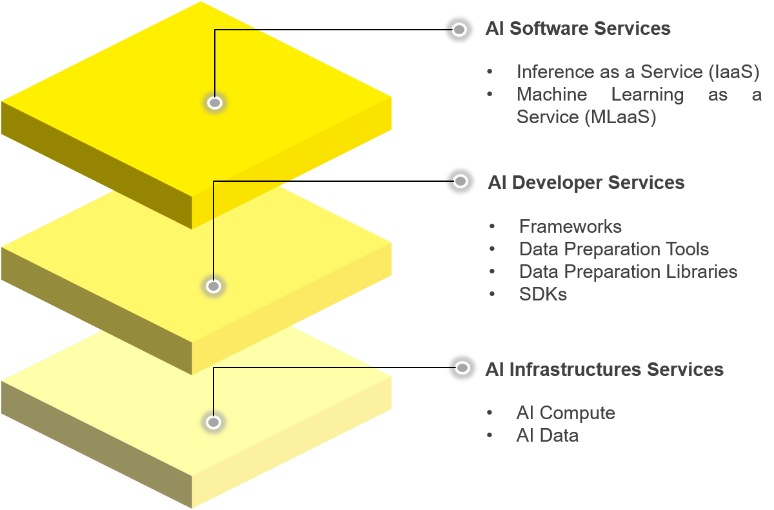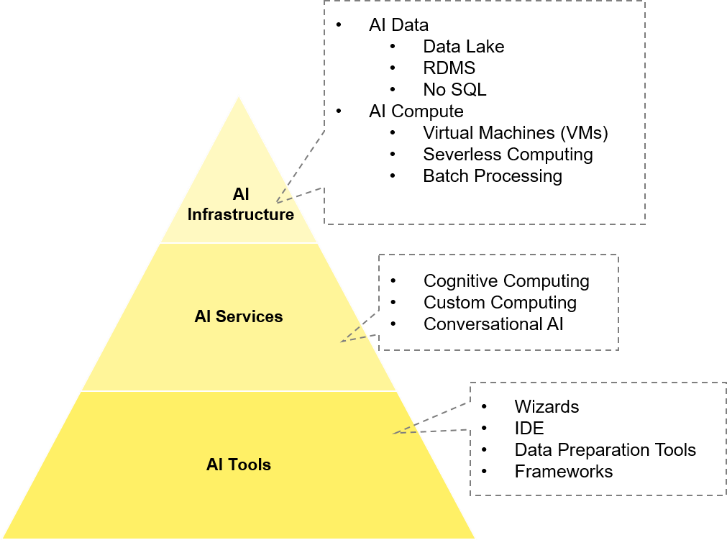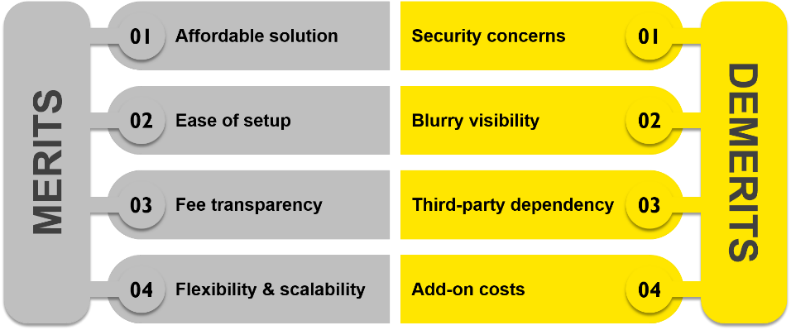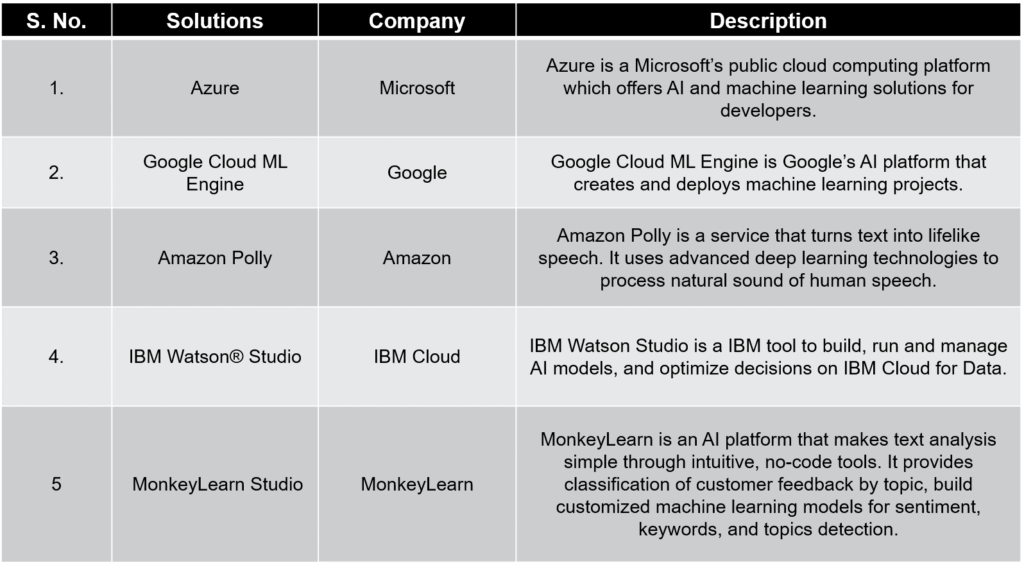With the increasing demand for artificial intelligence in data processing and computation, Artificial intelligence as a service (AIaaS) has become the need of the hour. AIaaS provides software, developer, and infrastructure services to the user. It consists of three components: AI infrastructure, AI service, and AI tools.
AIaaS, or AI as a service, is an affordable, flexible, and scalable solution, but it comes with its set of demerits like security concerns, visibility issues, and third-party dependency. There are various advantages of using AIaaS, but some challenges are faced during its implementation. Microsoft, Google, Amazon, and IBM are a few technology providers in the domain.
Artificial Intelligence as a service (AIaaS) is a service that outsources AI to enable individuals and companies to explore and scale AI techniques at a minimal cost. It provides AI tools that help companies to apply and scale AI techniques. It is cost-effective as compared to implementing in-house AI. The system does not necessarily need full customization for AI tool implementation. The third-party vendor makes minor adjustments for the system to access the AI facilities.
Services Provided by AI
Artificial Intelligence can provide services at various levels. These levels are majorly classified into the below three categories:

AI Software Services:
Developing and training an AI model is costly and time-consuming. A type of AI software service is prepared to provide pre-trained AI models to users for faster and cheaper processing.
AIaaS is also called inference as a service that provides machine-learning-based AI software. Users can customize machine learning models and create them using AIaaS.
AI Developer Services:
AI developer service offers tools and frameworks that enable developers to do faster coding and provide easier integration with APIs, such as PyCharm, Microsoft VS Code, Jupyter, or MATLAB. AIaaS providers offer data manipulation tools that extract, transform, and load data to machine learning algorithms for training and evaluation.
Users provide raw data to AI data preparation service, and AI-as-a-service automatically provides pre and post-processing. This solves the problem of data conversion and increases convenience for the users.
AI as a service also provides AI developer services by giving developers access to tools that help them implement code to bring out AI capabilities.
AI Infrastructures Services:
AIaaS offers AI infrastructure services comprising raw computational power to build and train AI algorithms and network and storage capacities to store and share data
Structural Components of AIaaS

AI Infrastructure:
It supports underlying AI and ML models. AI Data and AI computing are the two fundamental pillars of these models.
- AI data: A functional ML model is defined as applying a large volume of data to statistical algorithms. Developing these models aims to learn the pattern in the existing data. The model analyses a large volume of data to increase the accuracy percentage of the predictions.
- AI compute: AI computing services include VMs, serverless computing, and batch processing. These computing methods are used to enhance parallel processing and automate ML tasks. Trained models are used in VMs and containers to perform computations.
AI services:
Public cloud vendors provide readily available APIs and services, decreasing the need for custom ML models for their consumption. These APIs and services offer the benefits owned by the cloud provider.
- Cognitive computing: Cognitive computing APIs include speech, text analytics, voice translation, and search. Using these APIs will help speed up and make processing the speech inputs faster and easier at a cheaper level.
- Custom computing: With the introduction of AIaaS, cloud providers are shifting their focus from generic computing to custom computing. Custom computing uses cognitive computing to process custom datasets. Users provide input data for training cognitive services. This reduces the manual selection of the algorithm for different data sets.
- Conversational AI: Cloud providers help developers integrate bots with voice and text across platforms by leveraging bot services. Web and mobile developers can add digital assistants to their applications using this service.
AI tools:
In addition to APIs and infrastructure, cloud vendors provide tools that can help data scientists and developers. Virtual machines (VMs), storage, and databases are synchronized with the data and compute platforms. AI tools promote the usage of VMs, storage, and databases for better and faster data analysis.
- Wizards: Amateur data scientists are served with wizards to reduce the complexity of training ML models. At the backend, these tools act as a multi-tenant development environment.
- Integrated development environment (IDE): Experienced cloud vendors are investing substantially in IDEs and browser-based notebooks that help in easy ML model testing and management. Such tools enable developers and data scientists to build smart applications with ease.
- Data preparation tools: The performance of ML models heavily depends on the quality of data. To ensure the top-notch efficiency of ML models, public cloud vendors are providing data preparation tools that can perform the extract, transform, load (ETL) job. The output of these ETL jobs is then fed into the ML pipeline for training and evaluation purposes.
- Frameworks: Cloud providers offer ready-to-go VM templates with frameworks to reduce complexity in setting up, installing, and configuring the required data science environment. Such VMs train complex neural networks and ML models as GPU-supported entities.
Merits and Demerits of AIaaS
The introduction of Artificial Intelligence (AI) in providing services in various sectors can be helpful but also challenging. There are certain demerits and merits to AI as a service.

Merits:
- Affordable solution – Introducing AIaaS will reduce the amount of time taken to develop and test AI models before final deployment, therefore providing an affordable solution.
- Ease of setup – AIaaS offers easy setup as no complicated installation is required. It allows plugins and gets direct access to the required AI features. This reduces the need for a dedicated team of IT professionals or complex infrastructure.
- Fee transparency – In an AIaaS solution, the user pays for the features that he/she is actively using and does not need to pay for the overall AIaaS package.
- Flexibility and Scalability – AIaaS allows companies to scale their AI feature list up or down based on the business or project needs. Such flexibility makes AIaaS suitable for companies that use AI to provide services.
Demerits:
- Security concerns – Using AIaaS results in providing valuable data to third-party vendors. This results in problems related to the privacy and security of the data.
- Blurry visibility – Using AIaaS results in valuable data being provided to third-party vendors. This results in problems related to the privacy and security of the data.
- Third-party dependency – The introduction of AIaaS will increase the dependency on third-party vendors to provide the right information. Any error in the data processing by a third party will result in greater loss to the user.
- Add-on costs – Though AIaaS provides cheaper solutions and services, with the increase in demand for additional features for data processing, there will be an increase in add-on costs for data processing. This will result in an increase in cost for the user.
Vendors of AI-as-a-service
Many big market players like Microsoft, Google, Amazon, IBM and MonkeyLearn have developed products to introduce AI as a service (AIaaS) solutions.. The below table provides an overview of the services provided by these players:

Conclusion
With the increase in the demand for machine learning models to calculate and process large amounts of data, there is also an increase in the problem of infrastructure for machine learning models. The implementation and training of the AI model are costly and time-consuming. Therefore, the introduction of AI as a service (AIaaS) will solve these problems to a large extent. AIaaS has many advantages, such as cheaper solutions, easy setup, transparency, flexibility, and scalability, as well as disadvantages of security concerns and dependency on the third party. Research is ongoing to provide open-source solutions for designing MLaaS architecture. Further, industry experts are also working in the direction of edge computing in the AIaaS to enable the vision of edge intelligence or edge AI